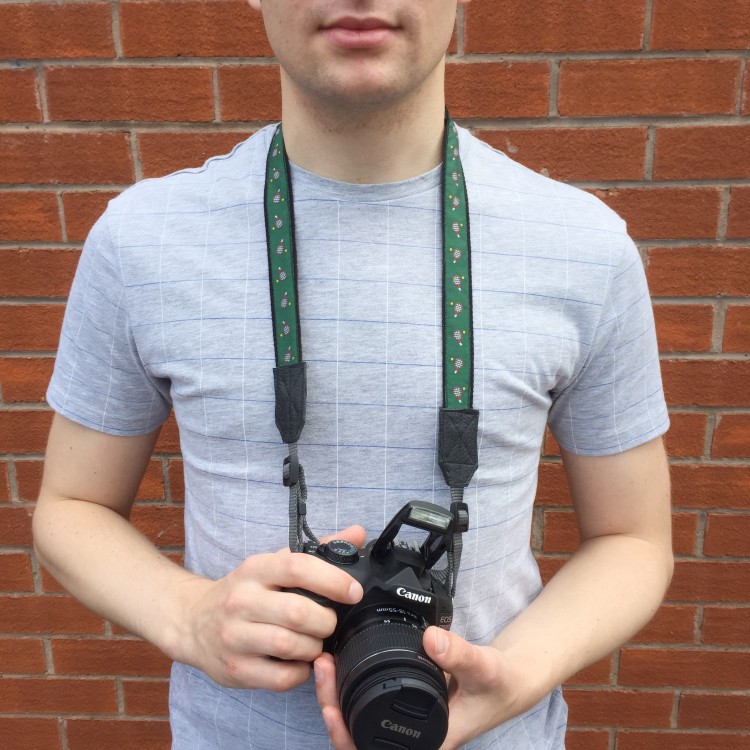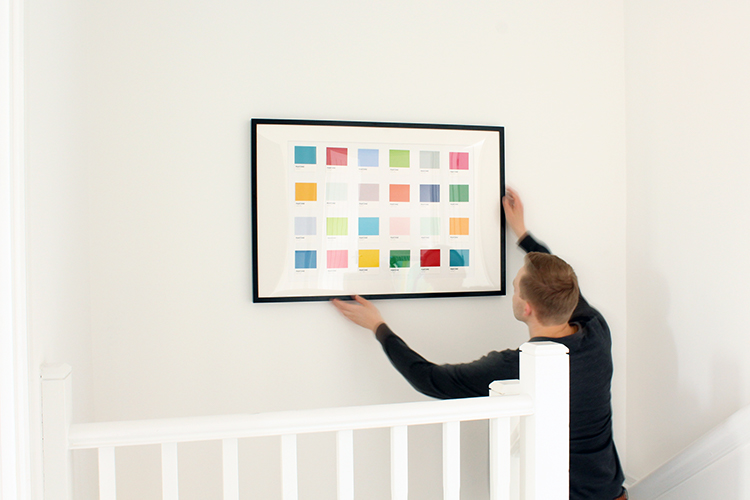
If you’re a crafter or interested in sewing, you’ve probably heard of appliqué before. But what exactly is it?
Put simply, appliqué is the process of applying small fabric pieces to a larger one, to create layered design. The benefit is that the designs can be really small or intricate – so you can achieve results that aren’t possible through traditional patchwork techniques.
This guide will teach you how to do machine appliqué. It’ll show you how to create appliqué pieces by hand or with a Cricut machine, then how to apply them with webbing and sew them in place.
In the photos, I’m making a DIY monstera leaf cushion from felt and a linen cushion cover. But the basic principles apply to all appliqué projects and fabrics!
Note: This article contains a few affiliate links (marked with *). If you click them and make a purchase, I’ll get a tiny commission at no extra cost to you. This helps me continue to publish free content like this. Thank you!

How to machine appliqué: the basic steps to follow
Supplies and tools
- Fabric blank (e.g. a cushion or quilt to apply the design to)
- Decorative fabric (to cut out the design from)
- Fusible webbing*
- Fabric scissors
- Pencil
- Iron
- Tea towel
- Sewing machine
- Satin stitch foot*
- Thread
Tutorial
Part 1: Prepare your appliqué design
1. Sketch your shape onto paper (or print out). The great thing about appliqué is that you can be pretty intricate and detailed with your designs. (Although if you’re a beginner, I’d recommend sticking to simple shapes to start with).
2. Place some fusible webbing such as Bondaweb* over the design, with the webbing side facing down. You can tell which side is the webbing, as it should be slightly rough to the touch. Trace the design directly onto the paper side of the webbing with a blunt pencil (too sharp and it could pierce the webbing).
3. Roughly cut around the traced webbing design, leaving a small excess around the edges. Don’t worry about being too neat here, as you’ll cut it out accurately in the next part.
4. Follow your fusible webbing instructions to apply the roughly cut design to your decorative fabric. (If you’re using Bondaweb, you should iron it for 5 seconds on a dry heat).
5. Once the fabric and webbing are fused together, use the pencil drawing you did in step 2 as a guide to cut neatly through both layers. This will leave you with your appliqué shape cut out with webbing applied to one side.
Top tip: If you own a Cricut (or other cutting machine), you can use that to speed up this process. There’s a section further down on how to do this.
Part 2: Apply your appliqué pieces to your fabric blank
6. Peel off the paper backing from the webbing you fused to your fabric in step 4. This will expose the second side of glue.
7. Place your appliqué piece onto your fabric blank, with the glue webbing facing down.
8. Follow the instructions on your fusible webbing to fuse it in position (if you’re using Bondaweb, cover it with a damp towel and iron for 6-7 seconds before leaving to cool for 20 minutes).
Part 3: Sew the appliqué shape into place (optional)
Note: Appliqué is usually finished off by stitching around the edges, either by machine or by hand. This firmly holds the pieces in place ands add a decorative border. Whilst this is not essential (you can simply glue it in place and stop there), it definitely adds a professional finish to your appliqué projects. So I’d recommend doing this part if you can!
9. Set your sewing machine to a wide zig-zag stitch with a short length (see more details in the FAQ section below). Fit a satin stitch foot* – this has a slight hollow to allow the densely packed appliqué stitches to pass under, without interrupting the movement of the foot.
10. Slowly stitch all around the edges of your appliqué piece, using either a matching or contrasting thread colour (depending on your preference). Aim for the zig-zag stitch to be two thirds on the appliqué piece, and one third on the background.
Top tip: If your fabric blank is lightweight, such as a thin T-shirt, you should use a stabiliser to give it support. Simply pin or baste a piece of stabilising material to the reverse of your blank (making sure it covers the full area to be appliquéd). Then stitch through this when you do the appliqué border. When finished, carefully tear or cut the stabiliser away.
11. When you get to a corner or tight curve, go very slowly. You might need to lower the needle and pivot the project slightly to get round the corner.
12. When you finish sewing around the edge, stitch over the first section by approx 5mm, then back stitch for 5mm. This will tie the stitches in place and prevent it from unthreading.
Top tip: You may need to adjust the tension of your sewing machine slightly. (In most cases, it’s likely that you will need to lower the upper thread tension). It’s best to practise on some scrap fabric first to get the settings just right.

How to appliqué with a Cricut or other cutting machine
Using a Cricut (or alternative cutting machine) can be a great way to make your appliqué projects even more professional looking. The machine will do all the hard work of cutting the shapes out for you – so you can choose even more intricate designs. It’s also a great way to get perfectly even and identical shapes, time after time.
The steps will show you how to appliqué with the Cricut Maker or Cricut Explore Air 2. But you can adapt them to whichever cutting machine you own.
Note: I’ve assumed that the appliqué fabric is lightweight cotton. If you’re using something else, you’ll need to adjust the settings detailed in step 5. For heavyweight fabrics, you may need to use a StrongGrip mat and/or deep cut blade.
- Cut out a piece of fusible webbing (at least 2cm larger than your appliqué shape on all sides).
- Place the webbing rough side down onto your decorative fabric, then fuse in place (according to the webbing instructions).
- Peel the paper backing off the webbing.
- Place the fused fabric onto a pink Cricut FabricGrip mat, with the fused side facing up (so the fabric side is stuck to the mat). Firmly press in place with a brayer, smoothing out any wrinkles.
- Follow the Cricut on-screen instructions to cut out your appliqué shape. Use a fine point blade and set the material to “bonded fabric”.
- Remove the cut shape from the Cricut mat and continue from part 2 step 7 in the original tutorial above.

Frequently asked questions
Which fabric is best for appliqué?
You can appliqué pretty much any fabric you feel comfortable in sewing. Cotton is probably the most common (and easiest), especially for quilts or clothing. However, I used a felt shape on a linen cushion in photos above. The main things to consider are whether you can machine sew it, and whether it’s robust enough to handle the tight zig-zag stitch without ripping. If in doubt, test on a small scrap first!
Do I need a special sewing machine for appliqué?
No, even a basic sewing machine will work just fine! All you need is the ability to do a zig-zag stitch, which most sewing machines can do.
Which sewing machine settings should I use for appliqué?
This largely depends on the complexity of your design, the machine you’re using and even personal preference. In general, you should aim to use a tight, wide zig-zag stitch. I’d recommend starting at 4mm wide and 0.8mm tightness, then adjusting from there.
Do I have to use a satin stitch foot for machine appliqué?
It’s not essential, but I would recommend it. A satin stitch foot has a slight hollow that the tight zig-zag stitching can pass through. This ensures that the foot will continue to sit flat on the project, without wobbling about.
If you don’t have a satin stitch foot, try to use an open toe foot made from clear plastic.
Can I use a decorative stitch to do machine appliqué?
Absolutely! You can use any stitch to finish off your appliqué project. The satin stitch (i.e. tight zig-zag) is traditional, but any decorative stitch can work too.
Can I use fabric glue instead of Bondaweb or fusible webbing?
You can use fabric glue, but I’d definitely recommend fusible webbing instead. The webbing is quicker, a lot less messy, and guarantees 100% edge-to-edge fusing. This isn’t necessarily the case with fabric glue, meaning your appliqué design could become raised or even wobble out of place before you manage to stitch it down.
Can I baste or pin my appliqué pieces instead?
I get it, it’s tempting! Basting and pinning is so much quicker. But don’t even go there. It’s essential that the appliqué pieces are completely stuck down from edge-to-edge, even before you stitch them. (The stitching is mostly there for decoration). This will stop them becoming raised or distorted over time.
If you found this useful, please share it on Pinterest! It really helps me to reach new people.

I hope this guide on how to appliqué has been useful! If you have any other questions that I’ve not covered, drop me a comment below and I’ll get back to you as soon as possible.
Thanks for reading and happy sewing! 🙂 – Mike.
















4 Comments
Patricia Curtis
August 1, 2022 at 10:38 pmThis is one of the absolute best instructions for applique that I have found! The instructions include great photos and tips for success. There are some areas which allowed the reader to drill down for more information. Mike you truly did a great job!
Mike
August 16, 2022 at 10:46 amThank you so much Patricia, I’m so glad you found my appliqué guide helpful! 🙂
Marshall
February 7, 2020 at 8:00 pmNice blog!
Mike
March 3, 2020 at 12:06 pmThanks so much! 🙂